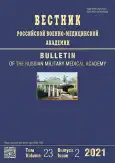Otorhinolaryngological contusions in mine-explosive injury
- Authors: Gorokhov A.A.1, Mironov V.G.1, Kasatkin A.N.2, Baytemirova N.N.1, Koroleva K.Y.1
-
Affiliations:
- Military Medical Academy named after S.M. Kirov of the Ministry of Defense of the Russian Federation
- The Main Military Clinical Hospital of the National Guard Troops of the Russian Federation
- Issue: Vol 23, No 2 (2021)
- Pages: 53-58
- Section: Clinical trials
- URL: https://journals.rcsi.science/1682-7392/article/view/71305
- DOI: https://doi.org/10.17816/brmma71305
- ID: 71305
Cite item
Abstract
Modern trends in the conduct of military conflicts dictate their own characteristics of the formation of the size and structure of sanitary losses of the otorhinolaryngological profile. Combat trauma to the organ of hearing is characterized not only by an increase in the total number of sanitary losses, but also by various features of the course of the wound process. The organ of hearing, with the development of weapons, becomes an increasingly unprotected and vulnerable area of impact of mine explosive weapons. However, such important characteristics as treatment, duration, and outcomes of ear, throat, and nose contusions are not sufficiently presented for adequate organization of medical support. Otorhinolaryngological contusions were considered in the total mass of contusion sanitary losses with a predominance of closed brain injury and often without taking into account otorhinolaryngological contusions. Victims completed treatment in separate medical battalions, hospitals and wards for the lightly wounded. The number of injured by shrapnel and concussion increases with the use of explosive weapons, due to an increase in associated wounds. The experience of the Great Patriotic War showed that otorhinolaryngological shell-shocked patients in frequency account for about 32.5% of all shell-shocked, therefore, in 67.5% of the remaining shell-shocked otorhinolaryngological contusions were concomitant, the main manifestation of the trauma was a closed brain injury. Otorhinolaryngological shell-shocked patients are a special case of general contusion or concussion-contusion syndrome from the direct impact of a sharp drop in air pressure during explosions. The leading manifestation of otorhinolaryngological contusion syndrome is vestibular and auditory disorders, decreased hearing acuity with a whole eardrum, which occurred in all victims. There were also neurological abnormalities such as short-term loss of consciousness, dizziness, fading nystagmus, stuttering, etc., which subsided a few days after the start of conservative therapy.
Full Text
##article.viewOnOriginalSite##About the authors
Andrey A. Gorokhov
Military Medical Academy named after S.M. Kirov of the Ministry of Defense of the Russian Federation
Email: vmeda-nio@mil.ru
doctor of medical sciences, professor
Russian Federation, Saint PetersburgVasily G. Mironov
Military Medical Academy named after S.M. Kirov of the Ministry of Defense of the Russian Federation
Email: mironov_lor@mail.ru
ORCID iD: 0000-0003-1502-7997
doctor of medical sciences, associate professor
Russian Federation, Saint PetersburgAlexei N. Kasatkin
The Main Military Clinical Hospital of the National Guard Troops of the Russian Federation
Email: koroljova1996@gmail.com
senior physician-otolaryngologist
Russian Federation, BalashikhaNaima N. Baytemirova
Military Medical Academy named after S.M. Kirov of the Ministry of Defense of the Russian Federation
Email: koroljova1996@gmail.com
postgraduate student
Russian Federation, Saint PetersburgKsenia Yu. Koroleva
Military Medical Academy named after S.M. Kirov of the Ministry of Defense of the Russian Federation
Author for correspondence.
Email: koroljova1996@gmail.com
ORCID iD: 0000-0001-5020-769X
student of the residency
Russian Federation, Saint PetersburgReferences
- Opyt sovetskoj mediciny v Velikoj Otechestvennoj vojne 1941– 1945 gg. Moscow: Medicina, 1951;8:387. (In Russ.).
- Gorohov AA, Shelepov AM. Voennaja otorinolaringologija: uchebnoe posobie. Saint Petersburg: SpecLit; 2014:271. (In Russ.).
- Vojachek VI. Kontuzionnye porazhenija s rasstrojstvami sluha i rechi Opyt sovetskoj mediciny v Velikoj Otechestvennoj vojne 1941–1945. v 35 t. Moscow: Medicina, 1951;8:328–365. (In Russ.).
- Gorohov AA. Zakonomernosti formirovanija sanitarnyh poter’ otorinolaringologicheskogo profilja. Vestnik Rossijskoj voenno-medicinskoj akademii. 2013;51(41):170–174. (In Russ.).
- Gofman, V.R. Organizacija medicinskoj pomoshhi i lechenija pri travmah LOR-organov v voennoe vremja. Leningrad: VMedA, 1990:75. (In Russ.).
- Gorohov AA. Travmy LOR-organov v uslovijah voennogo vremeni. Jetapnoe lechenie porazhennyh Otorinolaringologija: uchebnik. Saint Petersburg: SpecLit; 2019:188–195. (In Russ.).
- Gofman VR. Rezul’taty lechenija ranenij LOR-organov. Voenno-medicinskij zhurnal. 1992;(6):21–24. (In Russ.).
- Janov JuK. Minno-vzryvnye ranenija LOR-organov. Hirurgija minno-vzryvnyh ranenij pod red. L.N. Bisenkova. Saint Petersburg: Akropol: 1993:84–94. (In Russ.).
- Kulikovskij GG. Obshhaja harakteristika ranenij nosa, gorla i uha i kontuzionnyh porazhenij. Opyt sovetskoj mediciny v Velikoj Otechestvennoj vojne 1941–1945 gg. Ed. by E.I. Smirnova, N.N. Anichkova, N.N. Burdenko [et al.]. Moscow. 1951;8(22):13–46. (In Russ.).
- Kaznacheev VM, Kudryavcev BP, Savvin YuN. Klinicheskie rekomendacii po okazaniju medicinskoj pomoshhi postradavshim s povrezhdenijami golovy i shei v chrezvychajnyh situacijah. Klinicheskie rekomendacii po politravme. Moscow: Proekt, 2016:7–29. (In Russ.).
Supplementary files








